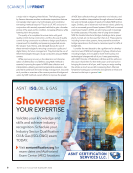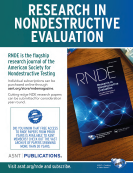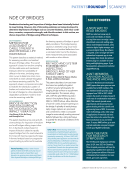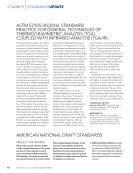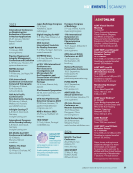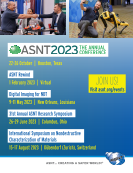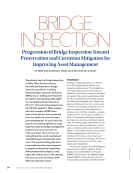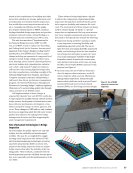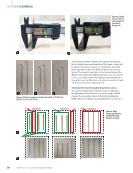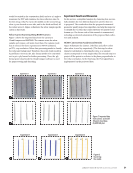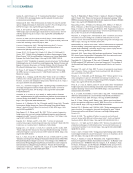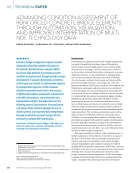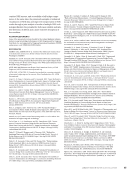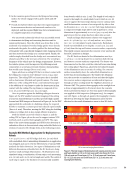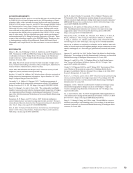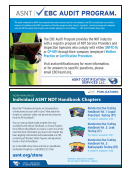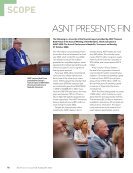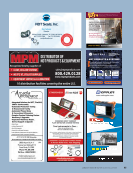provide an inspector with hands/voice-control robot operation following a flight mission plan, aNDT&E, and intraoperative hands-free access to complex data, real environments, and two-way communication. As an engine of the MR interface, the World Locking System (WLS) toolkit helps lock holograms in place as the user walks around so that “space pins” can be added to specific locations of the model to align perfectly with corresponding features in the physical bridge. The MR bridge environment imports a high-resolution 3D reconstructed and georeferenced bridge model at 5 cm/pixel from a laser scanner and stores and visualizes the metadata (such as past inspection reports and photos of discontinuities including size, shape, and location). The region of interest (ROI) discontinuities can be compared and annotated as needed by retrieving the historical inspection data and appending the current inspection data. A database is established to automate the bridge inspection and reporting process according to the 2019 AASHTO Manual for Bridge Element Inspection. Therefore, the bridge element field inspection efficiency and accuracy can be dramatically improved with the developed MR interface. A point cloud model of the bridge on 10th Street in Rolla, Missouri, was established as shown in Figure 2 in SketchUp and Unity. The model texture and size were maintained. When the bridge was scaled 1:1 in Unity, it was the same size as the actual bridge. This allowed the bridge model to be overlaid over the actual bridge with virtual and physical features roughly aligned. The model was scaled, rotated, and repositioned in X, Y, Z direc- tions either manually or by inputting an accurate desirable value to improve the accuracy of bridge alignment. WLS and its space pin feature was implemented to align local features of the bridge. WLS used an alignment manager called the Frozen Engine to lock the world space. Space pins were added as small objects that could be individually posi- tioned on physical objects at runtime, and then the Frozen Engine would adjust the view of the model to align. In this way, the bridge model was aligned more accurately and anchored perfectly with the real bridge for future revisits. After the 3D bridge model was overlaid with the real bridge asset, the Photograph mode can capture the discontinuity areas and localize them correspondingly. The discontinuity pictures and their locations, preliminary bridge element category (subjected to later review and confirmation) and their service conditions were annotated as illustrated in Figure 2. The dis- continuity metadata were saved to a .csv file together with the bridge inspection legacy data for cloud synchronization with the Azure SQL database. The Measure mode allowed the user to select the start point and then raycast measurement points in sequence. The dimension measurement along specific surfaces was enabled for bridge element inspections. Similarly, the quantity mea- surement for certain discontinuity areas or volumes was done for each structural component or limit state in service. The Control mode (to be developed) will enable the user to guide the navigation of robotic platform according to a predefined mission plan and execute an aNDT&E task. The user will closely coordinate these tasks with the UAV/robotic platform and an on-site safety worker through wireless com- munication. The task will not be directly executed at the UAV or robotic platform but teleoperated by the user through haptic sensing and dexterous manipulation (Kim 2021). The Display mode allowed the discontinuity photo, the measured distance, and/or flight and test scenario to be visualized for further analysis. Besides the local database where information was fed directly from the application at runtime, an Azure cloud database based on SQL was accessi- ble whenever any internet connection became available. This allowed the operator to work in a remote site, then synchronize the data collected locally to the cloud database. This practice is crucial to prevent data loss and allow data access anytime and anywhere. Robotic Platforms to Support aNDT&E In current practices, a moving inspection platform that costs about US$1 million, as shown in Figure 3a, is often installed between girders in the superstructure of river-crossing bridges due to access needs during bridge inspection and main- tenance. Mobile platforms such as structural crawlers on concrete/masonry walls (Yang et al. 2019) and steel members (Nguyen and La 2019) have recently been developed to support bridge inspection with advanced data-driven evaluation tech- nologies based on aNDT. For example, a four-wheel magnet- ically attached structural crawler, as shown in Figure 3b, that Augmented reality (AR) Image of local defects Figure 2. Hand-free bridge inspection enabled by augmented reality. J A N U A R Y 2 0 2 3 • M AT E R I A L S E V A L U AT I O N 69 2301 ME Jan New.indd 69 12/20/22 8:15 AM
can move along the surface of steel bridges was manufactured. The climbing robot measures 12 × 10 × 12 in. (30.5 × 25.4 × 30.5 cm) and weighs 40 lb with each battery good for approximately one hour. It is equipped with 2 GoPro cameras, a LiDAR, and an IMU. Its ground control station (GCS) has 16 channels with a control range of 2 km. It has a NUC i7 computer, a monitor, and a joystick. The crawler includes two independent channels of robot teleoperation and monitoring. A Dell Optiplex computer processes the data from the LiDAR and cameras and is then transferred to the GCS for live monitoring. For remote control, Rx receives commands from the operator via the GCS’s joystick. An Arduino Mega processes these signals and then exports outputs to control the robot’s motors and steering servos via power amplifiers. The structural crawler in Figure 3b is mostly applicable to large areas with little or no obstacles. Transverse climbing of the crawler around an I-shaped beam or girder is not a trivial task. A climbing robot may have an insufficient footprint or inappropriate orientation to make a safe turn from the inner to outer face of a flange of I-beams or girders. In addition, the unexpected disengagement of a climbing robot from its attached steel bridge may be a safety concern for passengers on underpass highways or over rivers. Therefore, innovative UAVs that can interact with a bridge deck for its enhanced inspection and maintenance were recently proposed. Two example vehicles are presented and demonstrated in Figures 3c and 3d. (Note that Figure 3c is still in laboratory test stage and Figure 3d was tested on an actual bridge.) Additionally, more recent generations of the structural crawlers described in Nguyen et al. (2021) and Otsuki et al. (2022) improved mobility around acute angles. Figure 3c shows an uncrewed multimodal vehicle, called BridgeBot, that was driven by four propellers in a flying mode and by four DC motors in a traversing mode. Both actuation systems were powered by batteries. The mechanics of train wheels and beam trolleys were followed to allow the inspection vehicle to be attached to the edge of an I-beam bottom flange. The four clamping wheels were 3D printed and coated with urethane to promote a higher coefficient of friction against the beam. Each wheel was independently driven by an electric DC motor. As shown in Figure 3c, the BridgeBot can mimic the operation of a traditional inspection platform as shown in Figure 3a. The uncrewed vehicle will be used to facilitate the I-girder bridge inspection and deploy structural crawlers, such as shown in Figure 3b, on the bottom flange of bridge girders. The uncrewed vehicle and the structural crawlers will allow the inspection and local maintenance of more than 90% of the bridges in the National Bridge Inventory. The uncrewed vehicle can fly in air and traverse along a girder with an effec- tive vehicle-bridge engagement mechanism for a smooth transition from flying to traversing mode, or vice versa. Design criteria of the hybrid vehicle include, but are not limited to, the following: Ñ In the flying mode, the vehicle is stable with necessary posi- tioning precision and navigation guidance in a GPS-denied environment. Ñ In the traversing mode, the vehicle with necessary posi- tioning precision moves at a constant speed to provide a stable station for various measurements. Figure 3. Bridge-attached platforms for close-in bridge inspection: (a) the moving platform in current practice (b) the proposed structural crawler with four magnet wheels, which carries a RGB camera for visual inspection (c) the proposed hybrid flying and traversing uncrewed vehicle (BridgeBot) attached to a wooden deck and (d) the proposed ceiling UAV in contact with the deck, which carries a dual-sensor (thermal and optical) camera. ME | AERIALNDTFORBRIDGES 70 M AT E R I A L S E V A L U AT I O N • J A N U A R Y 2 0 2 3 2301 ME Jan New.indd 70 12/20/22 8:15 AM
ASNT grants non-exclusive, non-transferable license of this material to . All rights reserved. © ASNT 2025. To report unauthorized use, contact: customersupport@asnt.org











